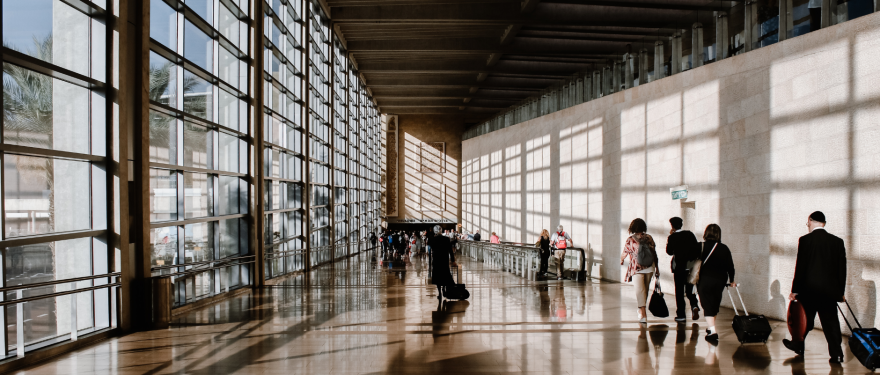Nonstop flights generally make traveling more pleasant—but can they lead to innovation, too, especially in the global context? Research suggests that they can, with important takeaways for managers reinstating business travel in a world emerging from the pandemic.
In a recent study, Harvard Business School Associate Professor Prithwiraj Choudhury examined how, when, and whether nonstop flights could spark an increase in new ideas. In a broad examination of flight and patent data, Choudhury and co-authors found that a 10 percent increase in nonstop flights between two locations led to a 1.4 percent increase in new patents between firms in those places.
"Even in a hybrid world, even in a world of work-from-anywhere, we still need to occasionally meet colleagues in person for social purposes."
Choudhury and colleagues teased out an additional wrinkle. Meeting face-to-face—made easier with nonstop flights—matters most when collaborators are in different time zones or overcoming cultural distance.
“It seems that, if the two locations are in the same time zone and are culturally similar, then Zoom is good enough. It’s fine to meet colleagues on Zoom and have productive conversations with them. But, if you’re working with a colleague who lives in a faraway time zone or is culturally different from you, you have to get on a flight and meet that person in person. That’s a big takeaway,” Choudhury says.
In a business world emerging from Zoom boxes, that’s an important wrinkle to consider. “Business travel is still required,” says Choudhury, who wrote the study with Dany Bahar, an associate professor at Brown University; Do Yoon Kim, an assistant professor at Boston College; and Wesley Koo, an assistant professor at INSEAD. “Even in a hybrid world, even in a world of work-from-anywhere, we still need to occasionally meet colleagues in person for social purposes.”
Marrying flight and patent data
Choudhury and colleagues examined flights from every airport worldwide—5,015 in all—between 2005 and 2015. Then, they matched those flights to global patent data filed by firms whenever they knew the address of each patent’s inventor and used cutting-edge empirical methods to determine causality.
In addition to the 1.4 percent uptick in patents, the authors found that new applications cited other patents 3.4 percent more often—evidence of innovation as measured by the US Patent and Trademark Office—when nonstop flights increase by 10 percent. The firms that benefitted most from nonstop flights tended to be bigger innovators overall, with more inventor stock and higher R&D spending. Many of these companies were also located within 50 miles of innovation hubs or in countries that were known as tech leaders.
The researchers also found that the effect of nonstop flights on innovation outcomes was stronger for routes with shorter north-south distances, which cross over less longitudinal distance.
Some business travel makes more of a difference
Choudhury believes these findings offer meaningful insight for policymakers, particularly in innovation hubs, as they contemplate adding nonstop flights to their airports. It’s also useful for corporate leaders evaluating the importance of business travel.
Choudhury’s work is especially prescient in a post-pandemic world. His broader scholarship focuses on the geography of work, particularly how location affects productivity and innovation. The ongoing rise of remote work, propelled by COVID-19, calls into question the importance of face-to-face interaction. These days, he’s often asked whether in-person business trips are worth it.
"We're showing that business travel matters for innovation, but it only matters if two firms' locations are either culturally or temporally far away from each other."
The study offers him an answer: Yes, with an important caveat.
“We’re showing that business travel matters for innovation, but it only matters if two firms’ locations are either culturally or temporally far away from each other,” he says—that is, if the two firms possess different cultural norms or don’t have overlapping business hours, defined as 1.5 hours or less.
For instance, colleagues who speak different languages and possess unique cultural norms around meeting styles would benefit from in-person meetings, whereas people who speak the same language and operate meetings similarly won’t realize the same benefit.
Choudhury hopes business leaders consider the research when refining post-pandemic work policies. Because of the vast sample size of flights used in this paper, he believes the findings are generalizable for all business leaders.
The power of Zoom
Choudhury was surprised that direct flights weren’t particularly helpful when people were in the same time zone, however.
“It just shows you the power of Zoom and similar communication technologies. The advent of these technologies has really shrunk distance,” he says.
Ultimately, Choudhury hopes that leaders realize that nonstop flights could overcome temporal barriers and help to spread knowledge—either through colleagues working in person or virtually, but on the same schedule—especially as work-from-home policies increase and the global workforce scatters.
“If you’re living in San Francisco, and your colleague is living in Vancouver, and you both speak excellent English, and you both understand exactly the same cultural norms, Zoom works great. If you’re meeting a colleague who lives in Beijing or South Korea, and you’re both culturally and temporally distant, those face-to-face meetings still have value,” Choudhury says.
This article was originally posted on HBS Working Knowledge.







